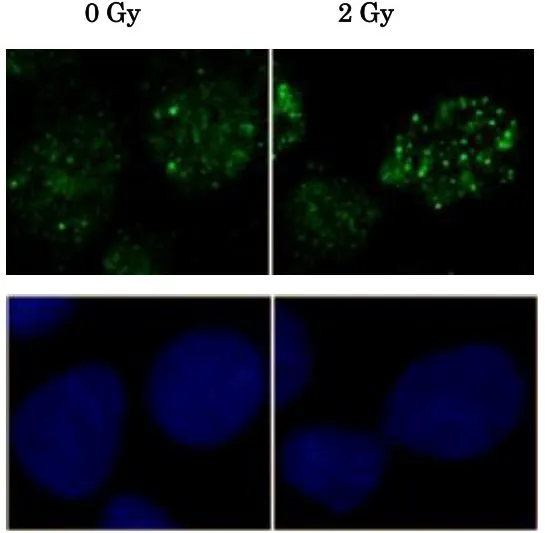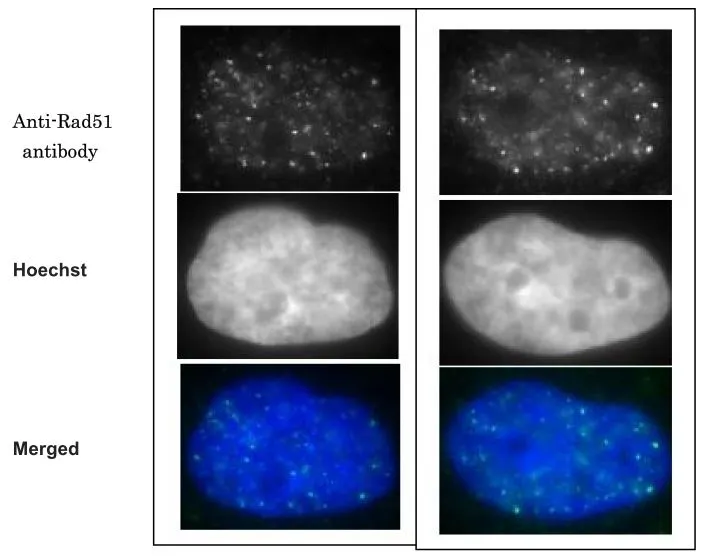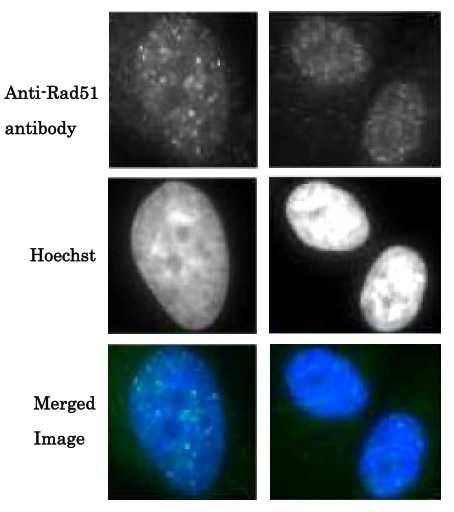Rad51 antibody [14B4]
GTX70230
ApplicationsImmunoFluorescence, ImmunoPrecipitation, Western Blot, ImmunoCytoChemistry, ImmunoHistoChemistry, ImmunoHistoChemistry Paraffin, Other Application
Product group Antibodies
TargetRAD51
Overview
- SupplierGeneTex
- Product NameRad51 antibody [14B4]
- Delivery Days Customer9
- Application Supplier NoteWB: 1:500-1:3000. ICC/IF: 1:100-1:1000. IHC-P: 1:100-1:1000. *Optimal dilutions/concentrations should be determined by the researcher.Not tested in other applications.
- ApplicationsImmunoFluorescence, ImmunoPrecipitation, Western Blot, ImmunoCytoChemistry, ImmunoHistoChemistry, ImmunoHistoChemistry Paraffin, Other Application
- CertificationResearch Use Only
- ClonalityMonoclonal
- Clone ID14B4
- Concentration1 mg/ml
- ConjugateUnconjugated
- Gene ID5888
- Target nameRAD51
- Target descriptionRAD51 recombinase
- Target synonymsBRCC5, FANCR, HRAD51, HsRad51, HsT16930, MRMV2, RAD51A, RECA, DNA repair protein RAD51 homolog 1, BRCA1/BRCA2-containing complex, subunit 5, RAD51 homolog A, RecA, E. coli, homolog of, RecA-like protein, recombination protein A
- HostMouse
- IsotypeIgG2a
- Protein IDQ06609
- Protein NameDNA repair protein RAD51 homolog 1
- Scientific DescriptionThe protein encoded by this gene is a member of the RAD51 protein family. RAD51 family members are highly similar to bacterial RecA and Saccharomyces cerevisiae Rad51, and are known to be involved in the homologous recombination and repair of DNA. This protein can interact with the ssDNA-binding protein RPA and RAD52, and it is thought to play roles in homologous pairing and strand transfer of DNA. This protein is also found to interact with BRCA1 and BRCA2, which may be important for the cellular response to DNA damage. BRCA2 is shown to regulate both the intracellular localization and DNA-binding ability of this protein. Loss of these controls following BRCA2 inactivation may be a key event leading to genomic instability and tumorigenesis. Multiple transcript variants encoding different isoforms have been found for this gene. [provided by RefSeq, Aug 2009]
- Storage Instruction-20°C or -80°C,2°C to 8°C
- UNSPSC12352203
References
- Wang YY, Cheng KH, Hung AC, et al. Differential impact of cytoplasmic vs. nuclear RAD51 expression on breast cancer progression and patient prognosis. Int J Oncol. 2024,64(2):pii: 12. doi: 10.3892/ijo.2023.5600.Read this paper
- Li J, Hu H, He J, et al. Effective sequential combined therapy with carboplatin and a CDC7 inhibitor in ovarian cancer. Transl Oncol. 2024,39:101825. doi: 10.1016/j.tranon.2023.101825Read this paper
- Yuan M, Chen T, Jin L, et al. A carrier-free supramolecular nano-twin-drug for overcoming irinotecan-resistance and enhancing efficacy against colorectal cancer. J Nanobiotechnology. 2023,21(1):393. doi: 10.1186/s12951-023-02157-xRead this paper
- Lin IC, Chang CH, Chong YB, et al. Role of Nucleobindin-2 in the Clinical Pathogenesis and Treatment Resistance of Glioblastoma. Cells. 2023,12(19). doi: 10.3390/cells12192420Read this paper
- Vollmer J, Ecker J, Hielscher T, et al. Class I HDAC inhibition reduces DNA damage repair capacity of MYC-amplified medulloblastoma cells. J Neurooncol. 2023,164(3):617-632. doi: 10.1007/s11060-023-04445-wRead this paper
- Park J, Kim JY, Park JW, et al. INHAT subunit SET/TAF-Iβ regulates PRC1-independent H2AK119 mono-ubiquitination via E3 ligase MIB1 in colon cancer. NAR Cancer. 2023,5(3):zcad050. doi: 10.1093/narcan/zcad050Read this paper
- van Wijk LM, Vermeulen S, Ter Haar NT, et al. Performance of a RAD51-based functional HRD test on paraffin-embedded breast cancer tissue. Breast Cancer Res Treat. 2023,202(3):607-616. doi: 10.1007/s10549-023-07102-yRead this paper
- Ter Brugge P, Moser SC, Bièche I, et al. Homologous recombination deficiency derived from whole-genome sequencing predicts platinum response in triple-negative breast cancers. Nat Commun. 2023,14(1):1958. doi: 10.1038/s41467-023-37537-2Read this paper
- Capala ME, Pachler KS, Lauwers I, et al. Ex Vivo Functional Assay for Evaluating Treatment Response in Tumor Tissue of Head and Neck Squamous Cell Carcinoma. Cancers (Basel). 2023,15(2). doi: 10.3390/cancers15020478Read this paper
- Lu X, He Y, Johnston RL, et al. CBL0137 impairs homologous recombination repair and sensitizes high-grade serous ovarian carcinoma to PARP inhibitors. J Exp Clin Cancer Res. 2022,41(1):355. doi: 10.1186/s13046-022-02570-4Read this paper







